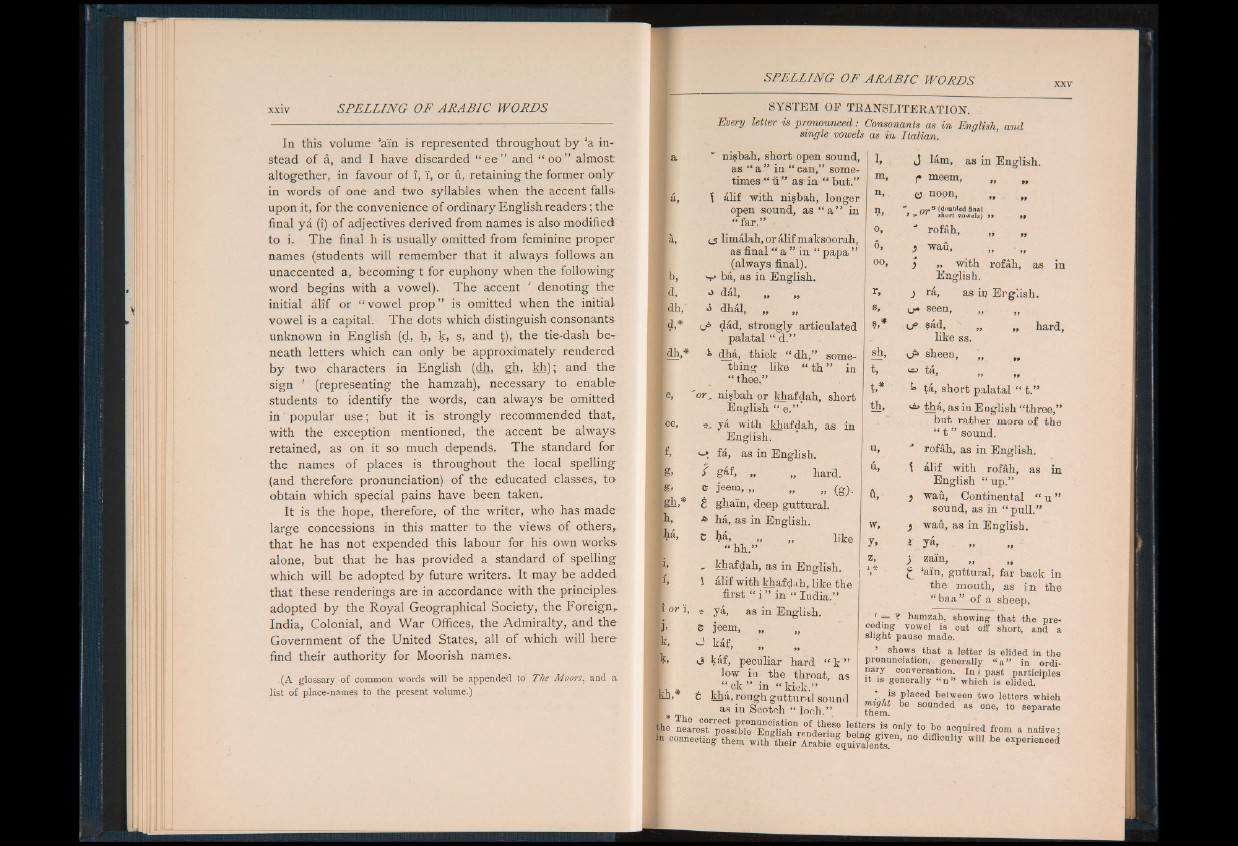
xxiv SPE L L IN G O F A R A B IC WORDS
In this volume 'ai'n is represented throughout by ‘a instead
of a, and I have discarded “ ee ” and “ oo ” almost
altogether, in favour of 1, i, or u, retaining the former only
in words of one and two syllables when the accent falls
upon it, for the convenience of ordinary English readers; the
final ya (1) o f adjectives derived from names is also modified
to i. The final h is usually omitted from feminine proper
names (students will remember that it always follows an
unaccented a, becoming t for euphony when the following
word begins with a vowel). The accent ' denoting the
initial alif or “ vowel prop” is omitted when the initial
vowel is a capital. The dots which distinguish consonants
unknown in English (d, h, k, s, and t), the tie-dash be-r
neath letters which can only be approximately rendered
by two characters in English (dh, gh, kh); and the
sign 1 (representing the hamzah), necessary to enable
students to identify the words, can always be omitted
in popular use; but it is strongly recommended that,
with the exception mentioned, the accent be always-
retained, as on it so much depends. The standard for
the names of places is throughout the local spelling
(and therefore pronunciation) of the educated classes, to
obtain which special pains have been taken.
It is the hope, therefore, of the writer, who has made
large concessions in this matter to the views of others,
that he has not expended this labour for his own works
alone, but that he has provided a standard of spelling
which will be adopted by future writers. It may be added
that these renderings are in accordance with the principles-
adopted by the Royal Geographical Society, the Foreign,
India, Colonial, and War Offices, the Admiralty, and the-
Government of the United States, all of which will here
find their authority for Moorish names.
.(A glossary of Common words will be appended to The Moors, and a.
list of place-names to the present volume.)
SYSTEM OF TRANSLITERATION.
Every letter is pronounced: Consonants as in English and
single vowels as in Italian.
■ a,
a,
b’
I d ,
■dh,
■dli*
B e’
ee,
I f ,
K h ,*
h,
ha,
j i,/
m ,
Si or i,
B
I ’
Ik,
lh , *
' nisbah, short open sound,
as “ a ” in “ can,” sometimes
“ h.” as in “ but.”
f alif with nisbah, longer
open sound, as “ a ” in
“ far.” -
tS limalah, or alif maksoorah,
as final “ a ” in “ papa ”
(always final).
v> ba, as in English,
dal, „ „
6 dhal, „ „
A dad, strongly articulated
palatal “ d.”
k dha, thick “ dh,” something
like “ th ” in
“ thee.”
' or_ nisbah or khafdah, short
English “ e.”
ya with khafdah, as in
English.
>-*. fa, as in English.
> gaf, „ „ hard.
© jeem, „ „ „ (g).
t ghain, deep guttural.
* ha, as in English.
© ha, ,, „ like
“ hh.”
- khafdah, as in English.
1 alif with khafdah, like the
first “ i ” in “ India.”
* ya, as in English.
B jeem, „
C kaf,9 ». 99.
kaf, peculiar hard “ k ”
low in the throat, as
. , “,ck ” in “ kick.”
C kha, rough guttural sound
as in Scotch “ loch.”
J lam, as in English.
r meem,
a noon, „ >f
® (doubled final
9 «* «hort v ow e ls ) i t 99
J rofah, ,, „
> wa*t, I • „
) „ with rofah, as in
English.
) ra, as in English.
ij - seen, „ „
u® ?ad, x „ „ hard,
like ss.
v> sheen, „ „
«■=» ta,’ » 99
k ta, short palatal “ t.”
i*i tha, as in English “three,”
but rather more of the
“ t ” sound.
rofah, as in English.
I alif with rofah, as in
English “ up.”
) wait, Continental “ u ”
sound, as in “ pull.”
j wau, as in English.
* y». „
j zain,
£ ‘«n, guttural, far back in
the mouth, as in the
“ baa” of a sheep.
%
m,
n,
9.
o,
6,
oo,
ri
s,
?,*
sh,
t,
t,#
th,
u,
a.
u,
W,
y*
z,
1 *
1 — ? hamzah, showing that the preceding
vowel is cut off short, and a
slight pause made.
’ shows that a letter is elided in the
pronunciation, generally “ a ” in ordinary
conversation. In j past participles
it is generally “ ii” which is elided.
I is placed between two letters which
might be sounded as one, to separate
them.
| t i» : I mein.
the I f 6” t aC^ ired * native;
in connecting them with their Arabic e q u i^ e S T “ ’ n° °ulty wlU be experienced